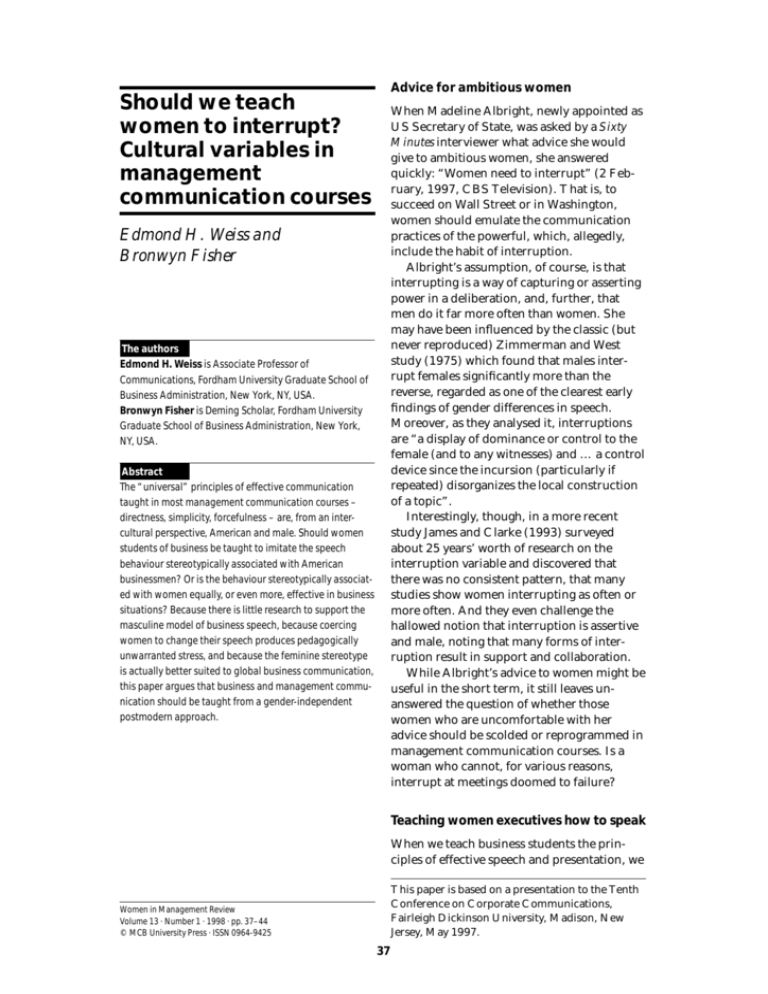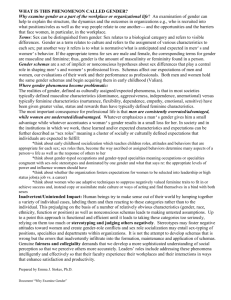Should we teach women to interrupt? Cultural variables in
advertisement

Advice for ambitious women Should we teach women to interrupt? Cultural variables in management communication courses When Madeline Albright, newly appointed as US Secretary of State, was asked by a Sixty Minutes interviewer what advice she would give to ambitious women, she answered quickly: “Women need to interrupt” (2 February, 1997, CBS Television). That is, to succeed on Wall Street or in Washington, women should emulate the communication practices of the powerful, which, allegedly, include the habit of interruption. Albright’s assumption, of course, is that interrupting is a way of capturing or asserting power in a deliberation, and, further, that men do it far more often than women. She may have been influenced by the classic (but never reproduced) Zimmerman and West study (1975) which found that males interrupt females significantly more than the reverse, regarded as one of the clearest early findings of gender differences in speech. Moreover, as they analysed it, interruptions are “a display of dominance or control to the female (and to any witnesses) and … a control device since the incursion (particularly if repeated) disorganizes the local construction of a topic”. Interestingly, though, in a more recent study James and Clarke (1993) surveyed about 25 years’ worth of research on the interruption variable and discovered that there was no consistent pattern, that many studies show women interrupting as often or more often. And they even challenge the hallowed notion that interruption is assertive and male, noting that many forms of interruption result in support and collaboration. While Albright’s advice to women might be useful in the short term, it still leaves unanswered the question of whether those women who are uncomfortable with her advice should be scolded or reprogrammed in management communication courses. Is a woman who cannot, for various reasons, interrupt at meetings doomed to failure? Edmond H. Weiss and Bronwyn Fisher The authors Edmond H. Weiss is Associate Professor of Communications, Fordham University Graduate School of Business Administration, New York, NY, USA. Bronwyn Fisher is Deming Scholar, Fordham University Graduate School of Business Administration, New York, NY, USA. Abstract The “universal” principles of effective communication taught in most management communication courses – directness, simplicity, forcefulness – are, from an intercultural perspective, American and male. Should women students of business be taught to imitate the speech behaviour stereotypically associated with American businessmen? Or is the behaviour stereotypically associated with women equally, or even more, effective in business situations? Because there is little research to support the masculine model of business speech, because coercing women to change their speech produces pedagogically unwarranted stress, and because the feminine stereotype is actually better suited to global business communication, this paper argues that business and management communication should be taught from a gender-independent postmodern approach. Teaching women executives how to speak When we teach business students the principles of effective speech and presentation, we This paper is based on a presentation to the Tenth Conference on Corporate Communications, Fairleigh Dickinson University, Madison, New Jersey, May 1997. Women in Management Review Volume 13 · Number 1 · 1998 · pp. 37–44 © MCB University Press · ISSN 0964-9425 37 Should we teach women to interrupt? Women in Management Review Edmond H. Weiss and Bronwyn Fisher Volume 13 · Number 1 · 1998 · 37–44 usually believe that we are teaching universal principles of communication and persuasion. We may, however, be teaching methods that are culturally narrow. Possibly, even the most unassailable precepts of communication – clarity, directness, simplicity, conciseness, flow – are not universal at all but, rather, individualistic and masculine. To illustrate, in teaching executive communication to MBA students, women (much more so than the men) are asked to repeat themselves and to speak louder. Some of the time one just cannot hear what is said, even though it is spoken nearby. Most of the time, though, we are encouraging a change in the speaking style of the woman student, presumably as part of her education. We want her to be a more effective business professional. As Tannen points out (1994), “anyone who is taller, more heftily built, with a lower more sonorous voice, begins with culturally recognized markers of authority” (p. 167). Moreover in practice, many women have been socialized to lower the volume of their voices just at times when men would raise theirs: for the work they do, but women’s socialization is usually at odds with the requirements of presenting to a group (p. 150). Is it pedagogically appropriate, then, to teach women to speak up? Or to interrupt? Or to refrain from apologizing or using “tag questions” (like “you know what I mean?”)? Have not stereotyped feminine behaviours – including quiet, supportive speech – proved effective in the careers of many women professionals? Is the imposition of what are generally male stereotypes of speech necessary to prepare the woman student for a career in business, especially given ongoing cultural changes in the workplace? Are the benefits of this imposition sufficiently great to warrant the associated discomfort or embarrassment to the student? And are our answers the same for the short and longer term? Sex, gender, and speech For some of us with a traditional education in language and literature, it is difficult to refer to men and women as genders. Until recently, men and women were the two sexes and gender was an attribute of words: masculine, feminine, or neuter. For example, when Supreme Court Justice Ruth Bader-Ginsburg was being interrogated by the Senate, as part of her nomination process, the senators kept asking her about gender-sensitive laws and she kept replying about sex-sensitive laws. But this diction battle has been long ago yielded to the social scientists. Powell (1993, p. 35) tells us that while: Ron tended to speak loudly when he was giving information, an activity that established his authority … Carol lowered her voice [when] she suggested solutions to the problems they were facing. By lowering her voice, Carol downplayed her suggestions, so as not to threaten Ron’s competence… (p. 182). Asking students to change their “natural” (that is, socialized over many years) style of speaking is a pedagogical problem. Asking a woman repeatedly to speak louder makes her uncomfortable and self-conscious. So does asking her to be more certain, (eliminating “hopefully” from her speech, for example), direct, and unapologetic. Matters are made worse, I suppose, when the teacher is a middle-aged man. In many ways, it is hard to imagine a more demanding challenge to women’s gender socialization than the platform presentation, the central activity in most business communication courses and workshops. Again, Tannen remarks: sex (or “biological” sex) is the term suggested by biological characteristics such as the chromosomal composition and reproductive apparatus of individuals … gender is a scheme for categorization of individuals that uses biological differences as the basis for assigning social differences. In other words, what is called gender these days is what used to be called sex roles. Gardner et al. (1994, p. 117) elaborate: Public speaking is frightening for almost anyone. But standing up in front of a large group of people, commanding attention, and talking authoritatively are extensions of the socialization most boys have been forced to endure … Many of the ways women have learned to be likable and feminine are liabilities when it comes to public presentations (p. 148). Both women and men must learn to handle this special situation well in order to get recognition Thus, sex involves actual differences … whereas gender focuses on people’s beliefs about how the sexes differ. Gender stereotypes are stable beliefs about sex differences that are shared by many people. Men have been traditionally viewed as high in instrumental traits such as aggressiveness and independence, whereas women have been seen as possessing expressive traits such as sensitivity, nurturance, and tactfulness. 38 Should we teach women to interrupt? Women in Management Review Edmond H. Weiss and Bronwyn Fisher Volume 13 · Number 1 · 1998 · 37–44 Although there is a tendency to assert a natural, biological link between a person’s sex and a set of stereotypical behaviours, cultural anthropologists long ago cautioned us against that naïvety. In Hall’s classic, The Silent Language, he tells us (1959, p. 49): Both men and women regarded topics introduced by men as tentative; many of these were quickly dropped. In contrast, topics introduced by men were treated as topics to be pursued… The failure of the women’s attempts at interaction is not due to anything inherent in their talk, but of the failure of men to respond, to do interactional work. It is a great mistake to think that the behavior which is observed in man (sic) is linked to physiology… Behavior that is exhibited by men in one culture may be classed as feminine in another. All cultures differentiate between men and women, and usually when a given behavior pattern becomes associated with one sex it will be dropped by the other [emphasis added]. Over the decades, however, not only have women changed, but the sociological methods for studying them have changed as well. Today, when researchers investigate stereotypical women’s speech, they find contradictions, nuances, and considerable variation across settings. For example, Carli (1989, p. 573) found that “gender differences in influenceability can be linked to differential treatment of men and women by their partners” [emphasis added]. That is, both men and women are capable of the full range of gender stereotypes, but they modify them to suit the audience. Similarly, Hall and Braunwald (1981, p. 99) found that “all speakers [men and women] were rated as more dominant, businesslike, condescending, and unpleasant when speaking to a man than when speaking to a woman”. The presumed modesty of women is also situation-dependent, not necessarily genderdependent, according to Heatherington et al. (1993, p. 750) who found that “Women’s estimates [of their future performance] were significantly lower [than men’s] only when they had to disclose their predictions to another whom they believed to be low achieving”. How, then, given these findings – including the controversy over interrupting – should women be encouraged to speak in business/ management communication courses? Should they be programmed to speak louder, to interrupt in meetings, and to make forceful selfpromoting presentations? Or does this, in effect, demean a legitimate, alternative communications culture? And even if corporations eventually learn to adapt to, and value, their alternative communication culture, is it fair to women students in the near term to encourage them to use less direct, more supportive, communication tactics? Further, are not indirect and collectivist approaches to business communication central to the current interest in improving business communications with Asian coun- So, if we notice differences in, for example, the typical volume of speech in male and female business students, it would be naïve to attribute most of the variability to differences in the anatomy of their respective respiratory systems. That is, almost every adult can learn to speak loudly and forcefully, regardless of sex differences in their physiology. How women adapt their speech Research over the past 25 years shows that most women use speech strategies in the workplace different from those used by most men. Put too simply, women’s speaking tends to be more indirect, conciliatory, collaborative, and modest. Men, especially successful male managers, tend to be more direct, confrontational, egoistic, and self-promoting. Especially in the early 1970s, these conclusions were clear and unambiguous. Horner (1972, p. 173), for example, observed that: Most highly competent and otherwise achievement oriented young women, when faced with a conflict between their feminine image and expressing their competencies or developing their abilities and interests, adjust their behaviors to their internalized sex-role stereotypes. Among women, the anticipation of success especially against a male competitor poses a threat to the sense of femininity and self-esteem and serves as a basis for becoming socially rejected… Further, Fishman (1978, p. 404) argues that, in business conversations, men and women are not even performing the same communication functions, with women, who ask more questions and make fewer direct assertions, typically taking it on themselves to keep the conversation and interaction going: …Women are more actively engaged in insuring interaction than the men. Women do support work while the men are talking and generally do active maintenance and continuation work in conversations. 39 Should we teach women to interrupt? Women in Management Review Edmond H. Weiss and Bronwyn Fisher Volume 13 · Number 1 · 1998 · 37–44 tries (and others that are judged “female” or “high-context”? And, if that is so, is this not another reason to moderate the traditional – direct, forceful, self-promoting – approaches to executive communication? likely to moderate enough in the next 10-20 years to require a new approach to the teaching of management communication. Put simply, this means encouraging everyone in the communication course, women or men, to suppress feminine stereotypes and adopt masculine stereotypes. Table I is excerpted from Wood’s (1997, p. 169) broad survey of these gender associations – not all of which, as has been shown, are clearly supported in the research: To a surprising extent, the behaviours in the right column are the curriculum of many business speech courses, and nearly all executive seminars and workshops on this subject. Many of these masculine tactics are addressed in Woodall’s How to Talk So Men will Listen (1990). She advises women to get to the point quickly, to choose single examples, to avoid digressions, and, having made their points, to stop speaking. On the subject of vocal volume, she is unambiguous: Goal programming: three models Teaching management communication to women raises problems in what operations researchers used to call “goal programming”: the process of defining the pattern of shortand intermediate-term goals that will most likely reach some agreed-on long-term goal. It is a critical part of curriculum design and social planning, where it is sometimes relatively easy to agree on long-term goals (e.g. literacy, full employment, crime-reduction) but often quite difficult to decide what to do in the short term. It is uncontroversial, for example, to assert that one goal of management education should be to provide men and women students with equal resources for career effectiveness. Ceteris paribus, men and women should experience similar rates of success and comparable levels of income. But, given that easy common ground, what should be done about women’s speech? In other words, is there more than one goal programme? Are all equally valid or effective? For the purpose of this essay, we shall explore three programmes: • Masculine. Women should be urged to mimic the stereotypical speech of men, because it will make them more successful. • Feminine. Women should stay with their stereotypical behaviour (only occasionally modifying it) because it is more effective than the masculine stereotype. • Postmodern. Women and men should forget that there are natural and appropriate ways for them to communicate and, instead, become more aware of their own culture: its strengths and weaknesses, its need to be “adapted” in other contexts. When analyzing your voice, pay attention to its volume. Many women are afraid to speak loudly because they have been told a loud voice sounds too masculine… It is certainly possible for women to speak loudly and still be considered women (p. 88). She adds that: One major culprit in poor vocal quality is whining… Ask your spouse, a friend, or an older child to tell you honestly if (and when) you have a whining tone in your voice. Nothing turns off a male audience any quicker than a whining voice. Females are a bit more tolerant, but women do each other a disservice this way (p. 89). What is most interesting about Woodall’s text is that, despite occasional references to the gender research and a few comments aimed directly at women readers, it is essentially a traditional guide to business speech. Its thesis (with some exceptions mentioned below) is that, despite some assets associated with women’s communication, the principles of effective speech are those that men seem to have mastered. The feminine programme The masculine programme The second programme is called “feminine”. It presumes that a transformation is underway in which feminine styles of communicating are already achieving legitimacy in the mainstream of Western, mainly American, business, and that, therefore, not only should no woman need to modify her speech We call this Albright-like approach the “masculine” programme. Its underlying warrant is that, even if the current style of management communication is an artefact of masculine domination, and even if that domination is likely to moderate in the long term, it is not 40 Should we teach women to interrupt? Women in Management Review Edmond H. Weiss and Bronwyn Fisher Volume 13 · Number 1 · 1998 · 37–44 Table I Masculine and feminine speech stereotypes Feminine speech Masculine speech Use talk to build and sustain rapport Share yourself and learn about others Use talk to create symmetry or equality Support others by understanding their feelings Include others in conversation; wait your turn Keep the conversation going Be tentative Establish a relationship with details and side comments Use talk to assert yourself and your ideas Personal disclosures make you vulnerable Use talk to establish your status and power Support others by giving advice or solving a problem for them Don’t share the talk stage; interrupt others to make your point Each person is on his or her own Be assertive Convey information and accomplish the goal; leave out extraneous details Source: Wood, J. (1997) The postmodern programme practices to succeed, but that the feminine gender-stereotypical behaviours may even be more effective. Advocates for this view are generally pluralists; they envisage a near-term future in which several communication styles will coexist in the workplace. Woodall, for example, urges women to develop a “conversational wardrobe”, and to suit the conversational “costume” to the occasion (1990, Ch. 10). It is a fundamentally rhetorical view of the problem, in which effectiveness comes from the communicator having made the right choices, in contrast to unthinking, stereotypical behaviour, which may be inappropriate in the situation. Others, however, imagine a change in the balance of power, with feminine modes becoming dominant; this transformation results from the gradual increase in the numbers of female executives, but also, more important, from the discovery that the styles of speech associated with women are actually more effective in achieving agreements and fostering teamwork than the traditional style associated with men. Thus, the new styles – introduced and demonstrated by women – will prevail, not because of the numbers of women, but the numbers on the bottom line. Carli, for example, also found that stereotypical feminine communication is better at influencing decisions, but that many women act as though the opposite were true: The third programme we call “postmodern”. It argues that in an era of global and intercultural business communication, the styles of communication nowadays associated with stereotypes of women in the workplace are commonplace among men in other business cultures, even in countries where women have not yet achieved an executive presence. Thus, ironically, even in countries where it might be problematical for an American company to have a woman spokesperson, the transaction would probably be more successful if it were given in the style currently associated with women. At the basis of postmodernism is an awareness of cultures, more specifically, an awareness that human behaviour is the composite effect of biological endowments (which are inherited), culture (which is learned), and personality differences (which are both inherited and learned). In this view, “human nature” accounts for far less of our behaviour than most people believe, and that laws of behaviour – such as the laws of communication effectiveness – are more cultural than natural. Hofstede’s (1997) paradigmatic research on the dimensions of culture was the result of surveying IBM employees around the world about their attitudes, opinions, and beliefs and applying factor analysis to the results. His research identified four dimensions that have become a commonplace in studies of intercultural communication: (1) individualism; (2) masculinity; When attempting to be influential, both men and women showed a decrease in stereotypically feminine behavior and agreements and an increase in stereotypically masculine behavior, task contributions, and disagreements, even though these changes are associated with reduced influence (1989, p. 573). 41 Should we teach women to interrupt? Women in Management Review Edmond H. Weiss and Bronwyn Fisher Volume 13 · Number 1 · 1998 · 37–44 women may have a hard time being respected as leaders or thinkers.) Further, cutting across Hofstede’s dimensions is Hall’s highly regarded analysis (1976) of Communication-Context. (3) power distance (attitude toward classes and hierarchies); (4) uncertainty avoidance (ability to tolerate ambiguity). Most relevant here are the first two dimensions. A high-context (HC) communication or message is one in which most of the information is either in the physical context or internalized in the person, while very little is in the coded, explicit, transmitted part of the message. A low-context (LC) communication is just the opposite: i.e. the mass of information is vested in the explicit code… (p. 91) Individualism pertains to societies in which the ties between individuals are loose: everyone is expected to look after himself or herself and his or her immediate family. Collectivism as its opposite pertains to societies in which people from birth onwards are integrated into strong, cohesive ingroups, which throughout people’s lifetime continue to protect them in exchange for unquestioning loyalty (1997, p. 51). Countries differ dramatically on this dimension (which seems to be independent of Hofstede’s schema); Hall’s research shows that while America is not the lowest in context, it is towards the low end. Germans, German-Swiss, and Scandinavians are lowest. In contrast, Chinese, Japanese, Koreans, and Vietnamese who speak Chinese are highest. Many of the problems for Westerners doing business in Asia emanate from the HC/LC clash. LC communication supports an individualistic, flexible, loose-relationship culture, and that is not what American business people find in the Far East. Hall tells us, “HC communications are frequently used as art forms. They act as a unifying, cohesive force, are long-lived and slow to change. LC communications do not unify; however, they can be changed easily and rapidly” (1976, p. 101). Even in countries that score high on Hofstede’s “masculinity” dimension, such practices as indirectness, modesty, patience, concern for the comfort of the group, and especially awareness of the non-verbal communication (“high-context”), are characteristic of successful presentations and negotiations. Japan, though it is very high on the masculine scale, is also one of the highest context cultures, valuing contextual cues over precision and univocality of speech. Kohl et al. (1993, p. 65) found that: The research also found the top five individualist countries are USA, Australia, Great Britain, Canada, The Netherlands and that the top five collectivist countries are Guatemala, Ecuador, Panama, Venezuela and Colombia. According to Hofstede: masculinity pertains to those societies in which social gender roles are clearly distinct (i.e. men are supposed to be assertive, tough, and focused on material success whereas women are supposed to be more modest, tender, and concerned with the quality of life); femininity pertains to societies in which gender roles overlap i.e. both men and women are supposed to be modest, tender, and concerned with the quality of life (pp. 82-3). Note that in masculine countries the women are not expected to be masculine, but in feminine countries the men are expected to be feminine. Indeed, this is the oddest of the dimensions. “The reason for labeling the second ‘work goals’ dimension ‘masculinity versus femininity’”, says Hofstede, “is that this dimension is the only one on which the men and women among the IBM employees scored consistently differently (except in countries at the extreme feminine pole)” (p. 82). In this study, the top five masculine countries are Japan, Austria, Venezuela, Italy, and Switzerland and the top five feminine countries are Sweden, Norway, The Netherlands, Denmark, Costa Rica. Although Hofstede’s research is relatively unconcerned with communication tactics, we can estimate from even this that the male American speech stereotype is quite individualistic and the female repertoire of communication practices might play better in more collectivist countries. (Unfortunately, the five most collectivist countries in Hofstede’s work are also countries in which The ambiguity of the Japanese language can be seen as a contributing factor toward many aspects of Japanese communication: • Greater reliance on oral, small-group communication, and less reliance on both largegroup and written communication. • Greater emphasis on visual communication. • The attitude that the reader/listener is primarily responsible for the success of communication. In other words, in Japan successful communication is credited more to the context-attuned 42 Should we teach women to interrupt? Women in Management Review Edmond H. Weiss and Bronwyn Fisher Volume 13 · Number 1 · 1998 · 37–44 effective listener than to the dynamic, forceful speaker. For some advocates of postmodern communication, the best strategy is reminiscent of Woodall’s “communication wardrobe”. Communicators are urged to “localize” their messages to the target culture, to become more or less individualistic, or higher- or lowercontext. But still others – including this author – wonder how successful people can be in adopting the mask of another culture after only a few hours, or even a few years, of study. Indeed, we wonder whether wearing a “costume” might compromise not only the effectiveness, but even the ethics of the communicator. conversing? Tannen reminds us that, “Before we give anyone advice or training in how to talk in different ways, we must realize that people believe their way of talking to be who they are” (p. 308). With this background, then, we propose five criteria for choosing among the three instructional programmes: (1) Well-being of the student (lack of pedagogically unwarranted stress). (2) Teachability (emphasizing learnable skills rather than innate talents). (3) Short-term career return (employability, promotion…). (4) Longer-term career return (potential in a global marketplace). (5) Research support (clear evidence of effectiveness, as opposed to conventional wisdom about public address and persuasion). Conclusion: which model? Although there may be some topics and skills that can be taught without engaging the deepest feelings of the student, speech is not one of them. Moreover, making students more self-conscious, even more self-aware, on any subject often produces reticence and other undesirable changes in their speech. For some, public speaking and presentation is terrifying. In our classes, many competent men and women, successful in both school and work, must cling to a lectern to still the trembling in their hands. According to Tannen (1994, p. 149), the experience is more complicated and stressful for women: Our interpretation of the literature cited, and professional experience, leads us to the assessments shown in Table II. Thus, while each programme has its merits, the postmodern programme seems to us the most prudent. Although it is not the least stressful for women, its stresses are applied evenly to both men and women. And the particular stress – culture shock, the discovery (as G.B. Shaw quipped) that the habits of our local tribe are not laws of human nature – does have an enlightening effect on most students. And, once we pass through the barrier of culture shock, we find a wealth of teaching materials, exercises, games, simulations … all of which enliven the study of business communication for men and women. The masculine model seems to be the choice for short-term application, especially “interviewing” skills. Interviewers and HR managers are still looking for direct, clear, …making presentations is a prime example of an activity in which behavior expected of women is at odds with what is expected of an effective professional. In fact, the very act of standing in front of a group talking about ideas is something that was unthinkable for women not so long ago. We oblige students to endure these stressful experiences in the belief that, eventually, with repetition, they will lose some fear and acquire some skills. But can we be sure that the harm we do is justified by the gain? Public speaking is, after all, an artificial form of communication. Successful adults sometimes go years at a time without needing to give a speech. Therefore, students who are not comfortable or effective public speakers do not need to feel intellectually inadequate. Indeed, they do not even have to consider themselves poor communicators. But what of other areas of business communication? Can we, should we, make a woman self-conscious about her way of Table II Assessment of the three models on five pedagogical criteria Criterion Masculine Well-being High stress for Least stressful most women Relies on Stereotypes are endowment easy to teach Teachability Short-term career Longer-term career Research support 43 Feminine Postmodern Culture-shock, with increased insight After the cultureshock, wealth of teaching material High in certain contexts Quick payoff Poor Unclear Surprisingly little Strong Ideal Often biased by Abundant and feminist agenda growing Should we teach women to interrupt? Women in Management Review Edmond H. Weiss and Bronwyn Fisher Volume 13 · Number 1 · 1998 · 37–44 articulate, confident, goal-oriented candidates, who speak forcefully. Indeed, some students from high-context cultures report that the process is extremely awkward for them, except when they are pursuing work in companies with such a culture. In the longer term, it is not clear that the masculine model is useful – even though it is a de facto Western standard for teaching people to speak. And, the research suggests that the alternatives are more effective. The research support for the classical model of public speaking is surprisingly small, given the millennia (from Aristotle onward) in which it has been taught. We know that the masculine style of speaking gets and holds attention, and that it facilitates memory. We even know that it can be used to inflame crowds. But do we know that it is useful in managing conflict, influencing others without coercion or manipulation, facilitating subtle agreements? The evidence is to the contrary, especially in the burgeoning field of international negotiations. By most arguments, then, the best plan is the postmodern, especially since it can be expanded to embrace gender stereotypes as cultural issues, thereby incorporating the best features of the feminine programme as well. But postmodernism is not without its problems. First, many faculties are culturally unaware; they insist that their local research findings are universal principles and that their customs and preferences are laws of nature. (An associate refused to participate in a course on inter-cultural negotiation, taking the position that small national variations are inconsequential and that the laws of negotiation behaviour are universal.) Only an intense and extended course in culture and intercultural communication could get them to pierce this veil and to see in how many ways communication seems to happen in the world. The second issue is that postmodernism, itself, is not without philosophical problems. It may, after all, be only an intellectual fad, distracting us from what really are laws of behaviour and human nature (such as the effectiveness of loud, clear speech). Or it may even be true that certain cultural practices are inherently better than others – given some overarching notion, some hypernorms, of what is in the best interests of the world community. Our current plan is try the postmodern programme for two years or so, to refrain from imposing one stereotype or another and calling it “effective communication”. In two years, we shall know more. References Carli, L. (1989), “Gender differences in interaction style and influence”, Journal of Personality and Social Psychology, Vol. 56 No. 4, pp. 565-76. Fishman, P. (1978), “Interaction: the work women do”, Social Problems, Vol. 25 No. 4, pp. 397-406. Gardner, W. et al. (1994), “Valuing women in management: an impression management perspective of gender diversity”, Management Communication Quarterly, Vol. 8 No. 2, pp. 115-64. Hall, E. (1959), The Silent Language, Doubleday, New York, NY. Hall, E. (1976), Beyond Culture, Anchor/Doubleday, New York, NY. Hall, J. and Braunwald, K. (1981), “Gender cues in conversation”, Journal of Personality and Social Psychology, Vol. 40 No. 1, pp. 99-110. Heatherington L. et al. (1993), “Two investigations of ‘female modesty’ in achievement situations”, Sex Roles, Vol. 29 Nos 11/12, pp. 739-54. Hofstede, G. (1997), Cultures and Organizations: Software of the Mind, McGraw-Hill, New York, NY. Horner, M. (1972), “Toward an understanding of achievement related conflicts in women”, Journal of Social Issues, Vol. 28 No. 2, pp. 157-75. James, D. and Clarke, S. (1993), “Women, men, and interruptions: a critical review”, in Tannen, D. (Ed.), Gender and Conversational Interaction, Oxford University Press, New York, NY, pp. 231-80. Kohl, J. et al. (1993), “The impact of language and culture on technical communication in Japan”, Technical Communication, Vol. 40 No. 1, pp. 62-73. Powell, G.N. (1993), Women and Men in Management, 2nd ed., Sage, Newbury Park, CA. Tannen, D. (1994), Talking From 9 to 5, William Morrow, New York, NY. Wood, J. (1997), “Gender, communication, and culture”, in Samovar, L. and Porter, R. (Eds), Intercultural Communication: A Reader, 8th ed., Wadsworth, Belmont, CA. Woodall, M. (1990), How to Talk So Men Will Listen, Contemporary Books, Chicago, IL. Zimmerman, D. and West, C. (1975), “Sex roles, interruptions and silences in conversation”, in Thorne, B. and Henley, N. (Eds), Language and Sex: Difference and Dominance, Newbury House, Rowley, MA, pp.105-29. 44








